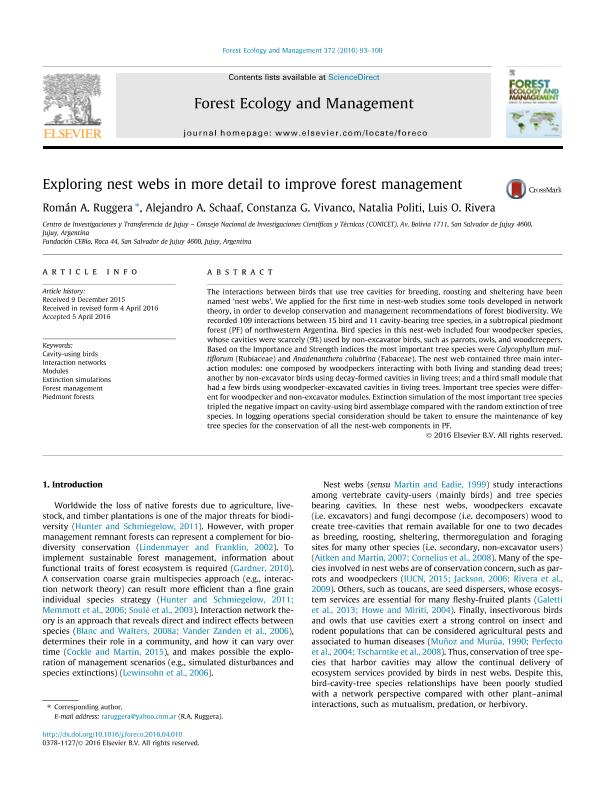Artículo
Exploring nest webs in more detail to improve forest management
Ruggera, Román Alberto ; Schaaf, Alejandro Alberto
; Schaaf, Alejandro Alberto ; Vivanco, Constanza Guadalupe
; Vivanco, Constanza Guadalupe ; Politi, Natalia
; Politi, Natalia ; Rivera, Luis Osvaldo
; Rivera, Luis Osvaldo
 ; Schaaf, Alejandro Alberto
; Schaaf, Alejandro Alberto ; Vivanco, Constanza Guadalupe
; Vivanco, Constanza Guadalupe ; Politi, Natalia
; Politi, Natalia ; Rivera, Luis Osvaldo
; Rivera, Luis Osvaldo
Fecha de publicación:
07/2016
Editorial:
Elsevier Science
Revista:
Forest Ecology and Management
ISSN:
0378-1127
Idioma:
Inglés
Tipo de recurso:
Artículo publicado
Clasificación temática:
Resumen
The interactions between birds that use tree cavities for breeding, roosting and sheltering have been named ‘nest webs’. We applied for the first time in nest-web studies some tools developed in network theory, in order to develop conservation and management recommendations of forest biodiversity. We recorded 109 interactions between 15 bird and 11 cavity-bearing tree species, in a subtropical piedmont forest (PF) of northwestern Argentina. Bird species in this nest-web included four woodpecker species, whose cavities were scarcely (9%) used by non-excavator birds, such as parrots, owls, and woodcreepers. Based on the Importance and Strength indices the most important tree species were Calycophyllum multiflorum (Rubiaceae) and Anadenanthera colubrina (Fabaceae). The nest web contained three main interaction modules: one composed by woodpeckers interacting with both living and standing dead trees; another by non-excavator birds using decay-formed cavities in living trees; and a third small module that had a few birds using woodpecker-excavated cavities in living trees. Important tree species were different for woodpecker and non-excavator modules. Extinction simulation of the most important tree species tripled the negative impact on cavity-using bird assemblage compared with the random extinction of tree species. In logging operations special consideration should be taken to ensure the maintenance of key tree species for the conservation of all the nest-web components in PF.
Palabras clave:
Cavity-Using Birds
,
Interaction Networks
,
Modules
,
Forest Management
Archivos asociados
Licencia
Identificadores
Colecciones
Articulos(SEDE CENTRAL)
Articulos de SEDE CENTRAL
Articulos de SEDE CENTRAL
Citación
Ruggera, Román Alberto; Schaaf, Alejandro Alberto; Vivanco, Constanza Guadalupe; Politi, Natalia; Rivera, Luis Osvaldo; Exploring nest webs in more detail to improve forest management; Elsevier Science; Forest Ecology and Management; 372; 7-2016; 93-100
Compartir
Altmétricas



